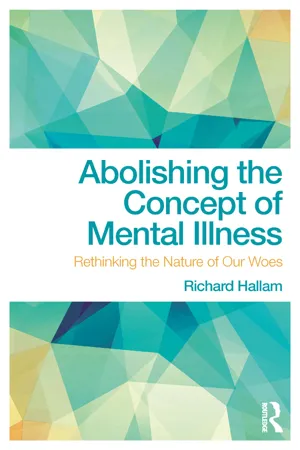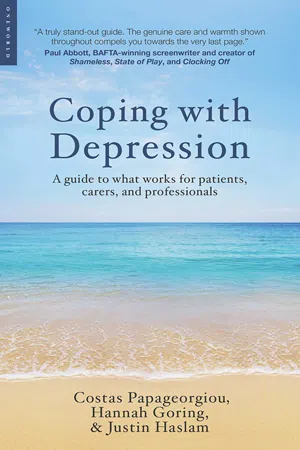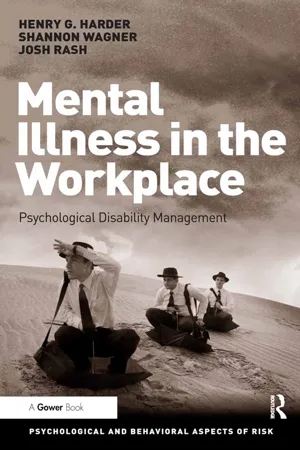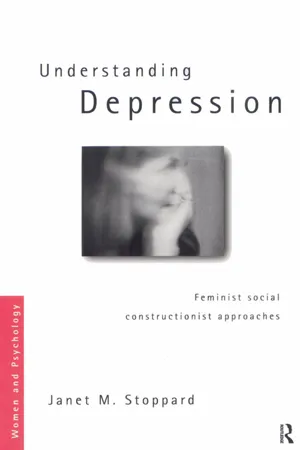Clinical Depression
Clinical depression is a mental health disorder characterized by persistent feelings of sadness, hopelessness, and loss of interest in activities. It can significantly impact a person's daily functioning, relationships, and overall well-being. Symptoms may include changes in appetite, sleep disturbances, fatigue, and difficulty concentrating. Treatment often involves a combination of therapy, medication, and lifestyle changes.
7 Key excerpts on "Clinical Depression"
- eBook - ePub
Abolishing the Concept of Mental Illness
Rethinking the Nature of Our Woes
- Richard Hallam(Author)
- 2018(Publication Date)
- Routledge(Publisher)
...Severity is indicated by a noticeable effect on areas of functioning such as appetite, sleep, mental concentration, self-worth, optimism, and sexual interest. The term ‘Clinical Depression’ means, in effect, that the alteration in mood is sufficiently extreme, enduring, and handicapping to warrant professional attention and support. However, it has proved extremely difficult to devise a set of criteria that clearly demarcate a clinical entity (or entities) centred on mood within the very broad spectrum of characteristics that make up normal variation. Criteria for a diagnosis of depression are not uniform, or uniformly applicable, across cultures (Pilgrim and Bentall, 1999). This is a serious objection when making a claim for an underlying disease process. A key to new discoveries is accurate description, and without it research flounders. With respect to depression, there is a degree of ambiguity and fluidity in diagnostic criteria that far exceeds the observational precision associated with the well-known physical diseases with which it has been compared. The American Psychiatric Association’s (APA) criteria for diagnosing ‘major depressive disorder’ (MDD) in DSM-5 specify that a person must report one of two core symptoms and at least four of seven secondary symptoms (DSM-5, 2013). Some of these secondary symptoms are binary (e.g. insomnia or hypersomnia) and so the list effectively increases to twenty. In 3,703 individuals diagnosed according to these criteria, Fried and Nesse (2015) identified 1,030 unique symptom profiles. If the medical syndrome that supposedly links all these symptoms together is a fiction, a unitary concept of depression might as well be dispensed with altogether (Fried, 2016). The psychological and behavioural phenomena that count as symptoms lie on continua, and so establishing that a symptom is present depends on exceeding a threshold of severity...
- eBook - ePub
Coping with Depression
A Guide to What Works for Patients, Carers, and Professionals
- Costas Papageorgiou, Hannah Goring, Justin Haslam(Authors)
- 2011(Publication Date)
- Oneworld Publications(Publisher)
...I also think that anti-depressant medication needs a new name, because these drugs also help to treat anxiety disorders such as phobias, obsessive-compulsive disorder and post-traumatic stress disorder. Depression often goes hand in hand with anxiety and both will usually respond to the same treatment. My clinical psychology colleagues and I work together, not apart or against each other, and they at times ask my patients to seek more advice on the potential for their medication to be adjusted or optimized if they can see someone reaching a plateau or struggling. Normal sadness versus Clinical Depression The key to discussions about treatment of depression using medication hinges on two things: the certainty of the diagnosis and the severity of the depression. This is because Clinical Depression is a neurobiological disorder, a real illness, which crosses the boundary past normal life sadness and melancholy. However, this issue is much more complicated than that, and beyond the scope of this book, as mild and chronic forms of depression are also viewed as neurobiological disorders. We use the phrase ‘Clinical Depression’ because of the absorption of the word depression into common parlance, which devalues it. People talk freely of being ‘depressed’, meaning by default that this relates to circumstances and is temporary. We react emotionally to life events, but one of the key jobs and expertise of a psychiatrist is to evaluate when this goes beyond normal reactions, and this certainly is not to medicalize normal life and experiences. As discussed in chapter 2, Clinical Depression is diagnosed when at least five symptoms out of a list of nine have been present for most of the day, nearly every day for at least two consecutive weeks. This is how normal sadness and Clinical Depression are distinguished. It might help to make the comparison with high blood pressure (hypertension) for a few reasons...
- eBook - ePub
- Constance Hammen, Ed Watkins(Authors)
- 2018(Publication Date)
- Routledge(Publisher)
...It is enormously impairing – and even deadly – and its effects on both the afflicted person and his or her family can be profoundly negative. Yet, we also have a number of effective treatments for depression and science is gaining considerable insight into the processes underpinning depression. Phenomenology of depressive experiences The term depression is used in everyday language to describe a range of experiences from a slightly noticeable and temporary mood decrease to a profoundly impaired and even life-threatening disorder. When used to describe a mood, the term conveys a temporary state of sadness and loss of energy or motivation that may last a few moments, hours, or even a few days. As such, it is usually a normal reaction to an upsetting event, or even an exaggerated description of a typical event (‘this weather is depressing’). A young man might feel sad for a few days following a romantic disappointment, or a woman might be discouraged for a few days upon being passed over for a job. Such experiences are not the topic of this book. Rather, the term ‘depression’ as used here refers to a constellation of experiences including not only mood, but also physical, mental and behavioural experiences that define more prolonged, impairing and severe conditions that may be clinically diagnosable as a syndrome of depression. The description at the beginning of the chapter may differ from the personal experiences of other depressed people, but all share features of the syndromes of depression. Each sufferer has features from the four different domains that define depressive disorders. The four general domains are affect, cognition, behaviour and physical functioning. Affective symptoms Depression is one of several disorders generically called affective disorders, referring to the manifestations of abnormal affect or mood, as a defining feature. Thus, depressed mood, sadness, feeling low, down in the dumps or empty are typical...
- eBook - ePub
Mental Illness in the Workplace
Psychological Disability Management
- Henry G. Harder, Shannon Wagner, Josh Rash(Authors)
- 2016(Publication Date)
- Routledge(Publisher)
...Chapter 4 Depression in the Workplace If depression is creeping up and must be faced, learn something about the nature of the beast: You may escape without a mauling. Dr R.W. Shepherd Introduction The most prevalent mental illness inside and outside of the workforce is depression. Occurring across the lifespan, depression is a chronic, recurrent condition that typically spans several decades. An international investigation examining the worldwide burden of depression found that the average major depressive episode lasts for 26 weeks in duration (Ustun, Ayuso-Mateos, Chatterji, et al., 2004). Indeed, helping workers acquire and maintain remission from depression is quickly proving a valuable cost-saving strategy for businesses worldwide. Depression is referred to as the common cold of mental disorders. Most of the time people describe depressed affect as a mild mood consisting of feeling down, sad or blue. Clinical Depression, on the other hand, differs qualitatively from mere depressed affect. Diagnosable Clinical Depression is defined by the experience of significant sadness that lasts most of the day, and occurs nearly every day. In addition to sad mood, depressed individuals often report experiencing disturbances in sleep and eating, chronic fatigue, difficulties making decisions or concentrating, feelings of worthlessness, thoughts of suicide and anhedonia or a loss of pleasure derived from previously pleasurable experiences. Depressed employees seem sad, withdrawn, angry, unmotivated or tired with diminished, erratic or error-prone performances (Kahn, 2008). Furthermore, their interpersonal relationships appear to be isolated, turbulent or diminished. These are all warning signs indicating the need for thoughtful consideration and possible referral in order to stave off a depressive episode. Depressive disorder exists on a severity gradient from mild forms termed dysthymia to severe crippling forms termed melancholic depressive disorder (Kahn, 2008)...
- eBook - ePub
Understanding Depression
Feminist Social Constructionist Approaches
- Janet Stoppard(Author)
- 2014(Publication Date)
- Routledge(Publisher)
...For instance, the diagnostic criteria for depressive disorder (“Major Depressive Disorder”) used by professionals in North America, and increasingly in many other parts of the world (cf. Culbertson 1997), were developed by the American Psychiatric Association (APA). These criteria are published in the Diagnostic and Statistical Manual of Mental Disorders [DSM] (APA 1994), and those listed in the recent (fourth) edition of the DSM for the main type of depressive disorder are shown in Table 1. In essence, the diagnostic criteria for depressive disorder consist of a list of subjective and bodily experiences. These experiences, termed symptoms, need to have been “present during the same two-week period” and to “represent a change from previous functioning” (see Table 1) to make a diagnosis of depressive disorder. An individual’s symptoms can meet the DSM criteria in a variety of ways, provided that at least one of the first two in the list (see Table 1) is present. These two symptoms are “depressed mood most of the day, nearly every day” and, “markedly diminished interest or pleasure in all, or almost all, activities most of the day, nearly every day”. There are seven additional symptoms (see Table 1), with at least four needing to be present before a diagnosis of depressive disorder is made. Diagnostic criteria for depressive disorder: format and content Several observations can be made about the format and content of the diagnostic criteria for depressive disorder given in the DSM. First, the criteria are formatted in a precise way, with clear directions for diagnostic decision-making (e.g. “Five [or more] of the following symptoms have been present”). Also, the form in which the criteria are presented, and their impersonal phrasing (there is no mention of the person being assessed), help to create an impression of detached scientific objectivity...
- eBook - ePub
The Theory and Treatment of Depression
Towards a Dynamic Interactionism Model
- Jozef Corveleyn, Patrick Luyten, Sidney J. Blatt, Hilde Lens-Gielis, Jozef Corveleyn, Patrick Luyten, Sidney J. Blatt, Hilde Lens-Gielis(Authors)
- 2013(Publication Date)
- Routledge(Publisher)
...Chapter 1 The Lifecycle of Depression Koen Demyttenaere, Lukas Van Oudenhove, & Jürgen De Fruyt Mood disorders in general and major depressive disorder (MDD) in particular are common, disabling psychiatric disorders with an estimated lifetime prevalence for MDD of around 17% in the community (Angst, 1997). The Belgian ESEMeD (European Study of Epidemiology of Mental Disorders) results confirm this estimate (lifetime prevalence of MDD 10.4% and 18.9% in males and females, respectively) (Alonso, Angermeyer, Bernert, Bruffaerts, et al., 2004). Furthermore, the prevalence rates of MDD seem to have increased considerably over the past decades. A substantial increase in the rates in cohorts born after World War II and a decrease in the age of onset have been found in several large epidemiologic and family studies (Klerman & Weissman, 1989). There is some evidence that these changes are at least partly artifactual, though. Identification phenomena, memory effects and differential mortality, among others, can explain why these findings may be to some extent due to artifacts (Klerman & Weissman, 1989). Over the past fifteen years, there has been increasing interest in the longitudinal course of MDD in the scientific literature. The discovery of psychotropic drugs in general and antidepressants in particular certainly made it possible to treat the acute phase of MDD more appropriately, but did this influence the long-term naturalistic outcome of the disorder? Nowadays, it is becoming more and more clear that MDD should be seen as a disorder that is chronic, progressive and recurrent in nature (Angst, 1997; Mueller et al., 1999; Solomon et al., 2000; Kessing, Andersen, Mortensen, & Bolwig, 1998)...
- eBook - ePub
Mending a Broken Mind
Healing the Whole Person Who Suffers with Clinical Depression
- Andrew Adam White(Author)
- 2021(Publication Date)
- Cascade Books(Publisher)
...5 Medical Treatment of Depression I am indebted to the authors of Clinical Psychopharmacology: Edition 8 for some of the information in this chapter and Appendix A. I have, however, put the information in my own words. I also include important information from many other sources including some in my Selective Bibliography. There are two main approaches to treating major depression: (1) medical treatment, especially antidepressant medications, and (2) counseling. Treatment of major depression with either one (antidepressants) or the other (counseling) or both together has been shown repeatedly in many rigorous research studies to: 1. shorten current depressive episodes 2. decrease psychosocial impairment 3. decrease risk of suicide 4. increase quality of life 5. decrease relapse rate Many experts believe that mild depression should be treated with psychotherapy alone; if the symptoms worsen, antidepressants can be prescribed. Another approach in mild depression is watchful waiting by monitoring symptoms to see if they resolve spontaneously without any treatment. If watchful waiting is chosen as the management strategy, the depressed person should be educated about symptoms that would necessitate a reevaluation. For moderate depression, antidepressant medications alone or counseling alone are often effective. Many experts, however, recommend using both. I certainly do. Most of these experts also believe that using antidepressants should almost always be part of the treatment plan for moderately severe and severe depression. In the rest of this chapter, we’ll address medical treatments for depression and bipolar disorder including bipolar depression. Detailed information on specific antidepressants is found in Appendix A. If you are on an antidepressant or your healthcare professional is going to prescribe one, you can look it up in this appendix...






